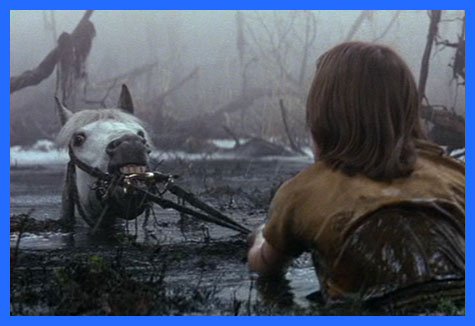
The 1971 PG-rated musical fantasy WILLY WONKA AND THE CHOCOLATE FACTORY is based on the book CHARLIE AND THE FACTORY by frequent kindertrauma inducer Roald Dahl (THE WITCHES, JAMES AND THE GIANT PEACH, etc.). Having initially spawned from the mind of Dahl, exactly zero people will be surprised to learn that freaky, bizarre, and unsettling things abound in the film. Diminutive, scornful orange-skinned, green-haired men bounce about, a shady creep known as Slugworth stalks amongst the shadows and it's clear any musical outburst revealing a lack of character may result in premature death. Still, no scene of presumed child torture and eradication that takes place within the movie can compare with the notorious transitional scene involving wacky Wonka (Gene Wilder) transporting his guests via Loompa-powered paddle boat through what appears to be the bowels of Hell.

"What is this, a freak out?" rightfully yelps Violet Beauregarde, as the surreal nightmare journey begins. As the boat enters the swirling tunnel, flashing psychedelic hues twirl and ooze across the screen and then give way to shocking images of gnawing insects and slithering snakes. Passengers become nauseated as the speed intensifies and a giant eyeball appears and is then eclipsed by a horrendous FACES OF DEATH-worthy close-up of a live chicken with its head being chopped off by a cleaver; even the movie's antagonist Mr. Slugworth materializes with a judgmental glare before vaporizing. Just when you think it couldn't get any worse, Wonka begins to sing a deathly dirge with the cadence of a mournful phantom…

There's no earthly way of knowing
Which direction we are going
There's no knowing where we're rowing
Or which way the river's flowing
Is it raining? Is it snowing?
Is a hurricane a blowing?

Wonka's voice becomes more desperate, intense, and frenzied as the boat and lava lamp colors accelerate…
Not a speck of light is showing
So the danger must be growing.
Are the fires of hell a glowing?
Is the grisly reaper mowing?

Yes! The danger must be growing
For the rowers keep on rowing.
And they're certainly not showing
Any signs that they are slowing!

Even the most hardened and cynical of Wonka's morally challenged guests are beyond terror and fear that their fates are sealed. Just as the pulsating nightmare reaches a fever pitch, spoiled Veruca Salt demands that her father make it stop. Mr. Salt yells at Wonka that they've gone far enough, Wonka agrees, and then WHAM: they've reached their brightly lit destination and all is (relatively) normal again. Somehow the group's trust in Wonka appears to be instantly restored but I (and many other young viewers, I'm sure) never looked at the guy the same way again.































































You must be logged in to post a comment.